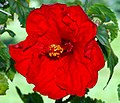Chinese rose marshmallow
| Chinese rose marshmallow | ||||||||||||
|---|---|---|---|---|---|---|---|---|---|---|---|---|

Chinese rose hibiscus ( Hibiscus rosa-sinensis ) |
||||||||||||
| Systematics | ||||||||||||
|
||||||||||||
| Scientific name | ||||||||||||
| Hibiscus rosa-sinensis | ||||||||||||
| L. |
The Chinese hibiscus ( Hibiscus rosa-sinensis ), also Chinese rose , Room Hibiscus or simply hibiscus (but this is actually the name for the genus Hibiscus ), is a plant from the family of mallow (Malvaceae). Nothing is known about the origin of the wild form, because Europeans only collected cultivated forms in many areas of Asia up to the Pacific islands; it is believed that Hibiscus rosa-sinensis is native to eastern India or China. There are many varieties that are used as an ornamental plant in parks and gardens and rooms.
description
The Chinese rose hawk grows as an evergreen shrub and reaches heights of 1 to 3 m. The leaves are stalked and simple. The petiole is 5 to 20 mm long. The 4 to 9 cm long and 2 to 5 cm wide leaf blades are broad to narrowly ovate. The leaves are hairy only on the veins on the underside of the leaf. The leaf margin is serrated or serrated. The thread-like stipules are hairy and 5 to 12 mm.
The flowers stand individually in the leaf axils on 3 to 7 cm long flower stalks . The hermaphroditic, radial symmetry and five-fold flowers have a diameter of 6 to 10 cm, in some varieties even larger. There are also filled varieties. The outer cup has six to nine thread-like lobes. The five bell-shaped sepals are about 1.5 to 2.5 cm long and have star hairs; the calyx lobes are about 5 to 15 mm long. The five obovate petals that stand together in a funnel shape can have a wide variety of colors. The petals are fused with the base of the androgynophore . In the subfamily Malvoideae , the filaments of the many stamens have grown together to form a tube surrounding the pistil, the so-called Columna ; it usually has lengths of 4 to 8 cm. Five carpels have become an ovary grown. There are five branches of the style with heady scars. They can bloom all year round.
Five-fan capsule fruits are formed, which are egg-shaped and about 2.5 cm long.
The number of chromosomes is 2n = 84, but the numbers 36, 38, 40, 44, 46, 52,70,76 92, 105, 118, 132, 138, 144 and 147 have also been, 90, is observed.
use
Varieties of Hibiscus rosa-sinensis are used as ornamental plants for parks, gardens, and rooms.
The roots, leaves and flowers are eaten raw or cooked. The flowers are pickled or used to color dishes.
The plant parts are used medicinally in a variety of ways.
In Asia, for example, the juice from the petals is used to dye hair, eyebrows and shoes black. Fibers up to 3 m long are obtained from the branches.
Stylized hibiscus flowers can be found as so-called Hawaii flowers on colorful summer clothing.
symbolism
In China , the hibiscus is a symbol of fame, fortune and splendor, as well as a young girl's sexual attraction. Mention should be made of the story The Hibiskusschirm , which is known in many variants .
Hibiscus has been the national flower of Malaysia since 1960 . Its five petals symbolize the five principles of the nation. In Malay it is called bunga raya , which means something like "big flower" or "big flower".
photos
Different varieties of Chinese rose hibiscus ( Hibiscus rosa-sinensis hybrids):
swell
- Ya Tang, Michael G. Gilbert & Laurence J. Dorr: Malvaceae in der Flora of China , Volume 12, p. 264: Hibiscus rosa-sinensis - Online.
- Sultanul Abedin: Malvaceae in the Flora of Pakistan : Description of Hibiscus rosa-sinensis - Online.
Individual evidence
- ↑ Hibiscus rosa-sinensis at Tropicos.org. In: IPCN Chromosome Reports . Missouri Botanical Garden, St. Louis
- ↑ a b c Entry in Plants for a Future. (engl.)
- ↑ Wolfram Eberhard: Lexicon Chinese Symbols , Munich 1994, keyword "Hibiskus"; Li Changqi: The hibiscus screen , in: Bauer / Franke (ed.): The Chinese chest , Munich 1959.
- ↑ The national flowers of Asia. (engl.)
Web links
- Thomas Meyer: Data sheet with identification key and photos at Flora-de: Flora von Deutschland (old name of the website: Flowers in Swabia )
- Private homepage, which presents everything worth knowing about hibiscus from many sides. Online version of a book on hibiscus . (engl.)
- The American Hibiscus Society .
- The Australian Hibiscus Society Inc.












